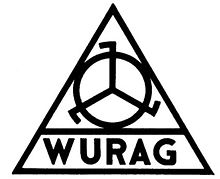WURAG iron and steel works
The WURAG iron and steel plants AG was a wire and cold rolling mill in Nahmer Valley in Hagen-Hohenlimburg that make that emerged from several wire drawing operations traced back to the 1855th During the heyday of the economic miracle , around 1000 workers and employees worked for WURAG, and the company was closed in 1993.
history
In July 1855, the trained wire drawer Christian Friedrich Boecker and his brother-in-law Ludwig Backhausen founded Friedrich Boecker Phillips Sohn & Co. , which uses the cold rolling method to manufacture flat wire that is used to furnish crinoline skirts . In 1858 the first steam engine was used there to drive the rollers, and the mill wheel that had previously been used was shut down. Boecker also campaigned for the construction of the Ruhr-Sieg railway line , which went into operation in 1860 and made freight traffic much easier. In 1884 Christian Friedrich Boecker and Ludwig Backhausen died shortly afterwards and Philipp Boecker took over the management of the company. Philip Boecker was then also one of the driving forces behind the establishment of the Hohenlimburg small railway , which started operations in 1898 and connected the industrial companies of the Nahmer Valley with the standard-gauge railway in Hohenlimburg.
In 1908 the neighboring plants Friedrich Boecker Phillips Sohn & Co. and Friedrich Koenig zu Hohenlimburg merged to form the Vereinigte Walz- und Röhrenwerke AG - the name WuRAG was created. The Friedrich Koenigs company had existed since 1873 and had expanded steadily from the start as a hammer mill , the start of wire drawing in 1880, the production of bar iron in 1885 and the construction of a cold rolling mill and tube rolling mill . In 1915 a new pipe factory hall was completed, but production was relocated to Wickede (Ruhr) and outsourced as early as 1917 .
In the course of the First World War , WURAG was taken over by Rheinische Stahlwerke in July 1916 and renamed the Rheinische Stahlwerke Dept. WURAG . A little later, Rheinstahl also merged with WURAG in the newly founded Vereinigte Stahlwerke AG (VESTAG) - WURAG will retain the tube plant in Wickede, but wire braiding and fine wire drawing will be transferred to the Westphalian Union in Hamm - and the name will be changed again, this time to the United Steel Works - Wuragwerk in Hohenlimburg . In 1926, the Boecker & Haver GmbH plant was also incorporated into the WURAG group between the Boecker and Koenig plants, which had been pulling wire since 1817 and belonged to the Phoenix Group , which also became part of VESTAG.
In December 1933 Wurag became formally independent again as WURAG Eisen- und Stahlwerke AG , 100% of the shares remained with the United Steelworks, however, the manufacture of tubes was completely separated in the form of the factory in Wickede, Wuragrohr GmbH .
After the Second World War, which the four plants survived unscathed and without dismantling , WURAG became a subsidiary of the Bochum Association in 1951 as part of the unbundling of Vestag , which in turn was taken over by Krupp in 1965 . WURAG also later changed its name to KRUPP. Operations ceased on September 29, 1993, as a result of the concentration measures following the Krupp / Hoesch merger in 1992.
The building in the headmistress was demolished in 2011.
literature
- Heinz Flieger: From the hundred-year history of WURAG, Eisen- und Stahlwerke Aktiengesellschaft. WURAG Hohenlimburg, 1955.
- Heinz Steguweit: Always strive for the whole - to the Chronicle of the Nahmer Valley , WURAG Hohenlimburg, approx. 1956.
Individual evidence
- ↑ Ute Theimann: Kruppians celebrate reunion. Old mates. In: derwesten.de . April 19, 2010, accessed December 19, 2014 .
- ↑ Volker Bremshey: 38 applicants want to tear down. Krupp-Werk IV. In: derwesten.de . September 16, 2011, accessed December 19, 2014 .
- ↑ Serious weakness. Corporations. In: spiegel.de . June 1, 1992, accessed December 19, 2014 .

